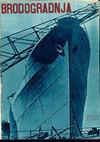ANALYSIS OF THE PRE-INJECTION CONFIGURATION IN A MARINE ENGINE THROUGH SEVERAL MCDM TECHNIQUES
IF 4.2
4区 工程技术
Q1 ENGINEERING, MARINE
引用次数: 4
Abstract
The present manuscript describes a computational model employed to characterize the performance and emissions of a commercial marine diesel engine. This model analyzes several pre-injection parameters, such as starting instant, quantity, and duration. The goal is to reduce nitrogen oxides (NOx), as well as its effect on emissions and consumption. Since some of the parameters considered have opposite effects on the results, the present work proposes a MCDM (Multiple-Criteria Decision Making) methodology to determine the most adequate pre-injection configuration. An important issue in MCDM models is the data normalization process. This operation is necessary to convert the available data into a non-dimensional common scale, thus allowing ranking and rating alternatives. It is important to select a suitable normalization technique, and several methods exist in the literature. This work considers five well-known normalization procedures: linear max, linear max-min, linear sum, vector, and logarithmic normalization. As to the solution technique, the study considers three MCDM models: WSM (Weighted Sum Method), WPM (Weighted Product Method) and TOPSIS (Technique for Order Preference by Similarity to Ideal Solution). The linear max, linear sum, vector, and logarithmic normalization procedures brought the same result: -22º CA ATDC pre-injection starting instant, 25% pre-injection quantity and 1-2º CA pre-injection duration. Nevertheless, the linear max min normalization procedure provided a result, which is different from the others and not recommended.基于MCDM技术的船用发动机预喷射结构分析
本文描述了一种用于表征商用船用柴油发动机性能和排放的计算模型。该模型分析了几个预喷射参数,如启动时刻、数量和持续时间。目标是减少氮氧化物(NOx)及其对排放和消费的影响。由于所考虑的一些参数对结果有相反的影响,本工作提出了一种MCDM(多准则决策)方法来确定最合适的预注射配置。MCDM模型中的一个重要问题是数据规范化过程。此操作对于将可用数据转换为无量纲通用量表是必要的,从而允许进行排名和评级。选择合适的归一化技术很重要,文献中有几种方法。这项工作考虑了五个众所周知的归一化过程:线性最大、线性最大最小、线性和、向量和对数归一化。在求解技术方面,本研究考虑了三种MCDM模型:WSM(加权和法)、WPM(加权乘积法)和TOPSIS(理想解相似排序偏好技术)。线性最大、线性和、矢量和对数归一化程序带来了相同的结果:-22ºCA ATDC预注射开始时刻、25%预注射量和1-2ºCA预注射持续时间。然而,线性最大-最小归一化程序提供了一个不同于其他程序的结果,不推荐使用。
本文章由计算机程序翻译,如有差异,请以英文原文为准。
求助全文
约1分钟内获得全文
求助全文
来源期刊

Brodogradnja
ENGINEERING, MARINE-
CiteScore
4.30
自引率
38.90%
发文量
33
审稿时长
>12 weeks
期刊介绍:
The journal is devoted to multidisciplinary researches in the fields of theoretical and experimental naval architecture and oceanology as well as to challenging problems in shipbuilding as well shipping, offshore and related shipbuilding industries worldwide. The aim of the journal is to integrate technical interests in shipbuilding, ocean engineering, sea and ocean shipping, inland navigation and intermodal transportation as well as environmental issues, overall safety, objects for wind, marine and hydrokinetic renewable energy production and sustainable transportation development at seas, oceans and inland waterways in relations to shipbuilding and naval architecture. The journal focuses on hydrodynamics, structures, reliability, materials, construction, design, optimization, production engineering, building and organization of building, project management, repair and maintenance planning, information systems in shipyards, quality assurance as well as outfitting, powering, autonomous marine vehicles, power plants and equipment onboard. Brodogradnja publishes original scientific papers, review papers, preliminary communications and important professional papers relevant in engineering and technology.
 求助内容:
求助内容: 应助结果提醒方式:
应助结果提醒方式:


